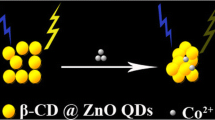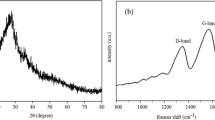Abstract
A simple, sensitive and selective chemiluminescence method is proposed for the determination of Acetylcysteine and Diclofenac in pharmaceutical samples. The method is based on the measuring light intensity of NaHCO3-H2O2 @ CdS chemiluminescence system in the absence and presence of Acetylcysteine and Diclofenac. It was found that the intensity of chemiluminescence is increased by addition of acetylcysteine while the light intensity is decreased with increasing diclofenac concentration. The CdS quantum dots nanoparticles were characterized by X-ray diffraction (XRD), Scanning electron microscopy (SEM), Fourier transform infrared spectroscopy (FTIR), UV–Vis spectrophotometry and Fluorescence spectroscopy. The optimum conditions for maximizing the CL emission intensity were studied by means of a Box–Behnken experimental design combined with response surface modeling (RSM) and quadratic programming. Under the optimal conditions, results for measurement of diclofenac was found as follows: linear range 1 × 10−5 - 1 × 10−9 Molar with R2 = 0.98, limit of detection 5 × 10−10 Molar and relative standard deviation of 2.4% for diclofenac; and for N-acetylcysteine was : linear range 1 × 10−6 - 1 × 10−9 Molar, the limit of detection 5 × 10−10 Molar, and the relative standard deviation of 3.4%.











Similar content being viewed by others
References
Shaidarova LG, Gedmina AV, Zhaldak ER, Chelnokova IA, Budnikov GK (2014) Voltammetric determination of acetylcysteine in drugs using an electrode modified by an osmium Hexacyanocobaltate film. Pharm Chem J 47:670–674
King M, Rubin BK (2002) Pharmacological approaches to discovery and development of new mucolytic agents. Adv Drug Deliv Rev 54:1475–1490
Beitollahi H, Mohadesi A, Mohammadi S, Akbari A (2012) Electrochemical behavior of a carbon paste electrode modified with 5-amino-3′, 4′-dimethyl-biphenyl-2-ol/carbon nanotube and its application for simultaneous determination of isoproterenol, acetaminophen and N-acetylcysteine. Electrochim Acta 68:220–226
Alvarez-Coque MCG, Hernandez MJM, Camanas RMV, Fernandez CM (1989) Spectrophotometric determination of N-acetylcysteine in drug formulations with o-phthalaldehyde and isoleucine. Analyst 114:975–977
Nozal MJ, Bernal JL, Toribio L, Marinero P, Moral O, Manzanas L, Rodriguez E (1997) Determination of glutathione, cysteine and N-acetylcysteine in rabbit eye tissues using high-performance liquid chromatography and post-column derivatization with 5, 5′-dithiobis (2-nitrobenzoic acid). J Chromatogr A 778:347–353
Lenik J (2014) A new potentiometric electrode incorporating functionalized β-cyclodextrins for diclofenac determination. Mater Sci Eng C 45:109–116
Jain R, Jadon N, Radhapyari K (2006) Determination of antihelminthic drug pyrantel pamoate in bulk and pharmaceutical formulations using electro-analytical methods. Talanta 70:383–386
Mostafa S, El-Sadek M, Alla EA (2002) Spectrophotometric determination of ciprofloxacin, enrofloxacin and pefloxacin through charge transfer complex formation. J Pharm Biomed Anal 27:133–142
Haginaka J (1991) Drug determination in serum by liquid chromatography with restricted access stationary phases. TrAC Trends Anal Chem 10:17–22
Zhou Y, Chen H, Ogawa N, Lin J-M (2011) Chemiluminescence from NaClO–H 2 O 2 and enhanced by l-cysteine capped Mn-doped ZnS quantum-dots. J Lumin 131:1991–1997
Chen HM, Huang XF, Xu L, Xu J, Chen KJ, Feng D (2000) Self-assembly and photoluminescence of CdS-mercaptoacetic clusters with internal structures. Superlattice Microst 27:1–5
Box GEP, Behnken DW (1960) Some new three level designs for the study of quantitative variables. Technometrics 2:455–475
Adinarayana K, Ellaiah P (2002) Response surface optimization of the critical medium components for the production of alkaline protease by a newly isolated bacillus sp. J Pharm Pharm Sci 5:272–278
Yu WW, Qu L, Guo W, Peng X (2003) Experimental determination of the extinction coefficient of CdTe, CdSe, and CdS nanocrystals. Chem Mater 15:2854–2860
Samadi-Maybodi A, Sadeghi-Maleki M-R (2015) In-situ synthesis of high stable CdS quantum dots and their application for photocatalytic degradation of dyes. Spectrochim Acta Part A Mol Biomol Spectrosc 152:156–164
Langford JI, Wilson AJC (1978) Scherrer after sixty years: a survey and some new results in the determination of crystallite size. J Appl Cryst 11:102–113
Pasandideh-Nadamani M, Omrani A, Sadeghi-Maleki MR, Samadi-Maybodi A (2016) Application of CdS quantum dots modified carbon paste electrode for monitoring the process of acetaminophen preparation. Anal Biochem 502:36–42
Chen H, Li R, Lin L, Guo G, Lin J-M (2010) Determination of l-ascorbic acid in human serum by chemiluminescence based on hydrogen peroxide–sodium hydrogen carbonate–CdSe/CdS quantum dots system. Talanta 81:1688–1696
Azizi SN, Chaichi MJ, Shakeri P, Bekhradnia A (2013) Determination of atropine using Mn-doped ZnS quantum dots as novel luminescent sensitizers. J Lumin 144:34–40. doi:10.1016/j.jlumin.2013.05.054
Liu M, Zhao L, Lin J-M (2006) Chemiluminescence energy transfer reaction for the on-line preparation of peroxymonocarbonate and Eu (II)-dipicolinate complex. J Phys Chem A 110:7509–7514
Xu W, McDonough RC III, Langsdorf B, Demas JN, DeGraff BA (1994) Oxygen sensors based on luminescence quenching: interactions of metal complexes with the polymer supports. Anal Chem 66:4133–4141
Ping J, Wu J, Wang Y, Ying Y (2012) Simultaneous determination of ascorbic acid, dopamine and uric acid using high-performance screen-printed graphene electrode. Biosens Bioelectron 34:70–76
Chen H, Lin L, Li H, Lin J-M (2014) Quantum dots-enhanced chemiluminescence: mechanism and application. Coord Chem Rev 263:86–100
Author information
Authors and Affiliations
Corresponding author
Rights and permissions
About this article
Cite this article
Samadi-Maybodi, A., Tilehkan, A. & Sadeghi-Maleki, MR. Determination of Diclofenac and N-Acetylcysteine by an Optimized Luminescence Method Using CdS Quantum Dots as Sensitizers. J Fluoresc 27, 1025–1034 (2017). https://doi.org/10.1007/s10895-017-2036-z
Received:
Accepted:
Published:
Issue Date:
DOI: https://doi.org/10.1007/s10895-017-2036-z




